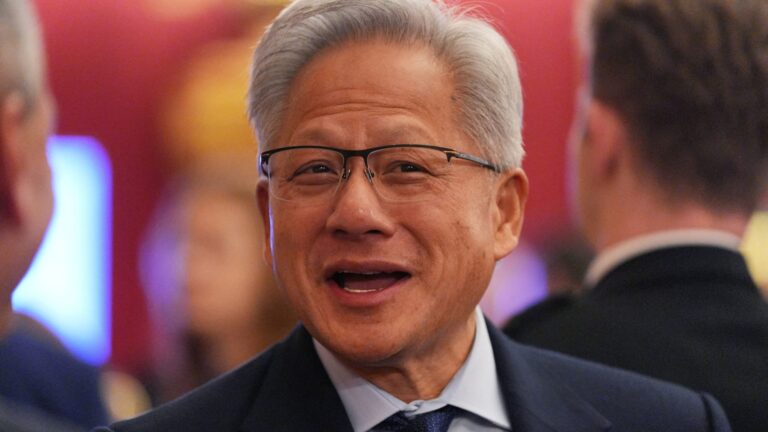Jensen Huang attends a reception for the 2025 Queen Elizabeth Prize for Engineering, at St James’ Palace in London, Brirain, Nov. 5, 2025.
Yui Mok | Via Reuters
Nvidia CEO Jensen Huang revealed in October that his company has $500 billion in orders, in 2025 and 2026 combined, for its chips that are at the heart of the AI boom.
For a company that has seen its quarterly revenue grow nearly 600% over the past four years, Huang’s statement was a sign that Nvidia is confident of another year of strong — but slowing — growth for its next cycle of chips, implying that the AI boom still has room to run.
“This is how much business is on the books. Half a trillion dollars worth so far,” Huang said at the company’s GTC conference in Washington.
Huang included 2025 revenue so far, sales of Nvidia’s current Blackwell graphics processing units and next year’s Rubin GPUs and also related parts like networking. After parsing through the details of Huang’s remarks, analysts concluded that the statement signaled a meaningfully higher year by revenue in 2026 than Wall Street had previously expected.
“NVDA’s disclosures suggest clear upside to current consensus estimates,” wrote Wolfe Research analyst Chris Caso in a November note. Caso estimated that Huang’s data point suggested data center sales that could be $60 billion over prior calendar 2026 estimates. He has the equivalent of a buy rating on the stock.
But Nvidia stock is trading 5% under where it was when Huang called Nvidia’s shot on Oct. 28.
It’s a reflection of the continued debate among investors about the AI boom, and whether a handful of big cloud companies called hyperscalers and AI labs are overspending on infrastructure.
When Nvidia reports third-quarter earnings on Wednesday, analysts polled by FactSet are expecting $1.25 in earnings per share on $54.83 billion of sales, which would be a 56% increase on a year-over-year basis. They’re also looking for guidance in the January quarter of $61.88 billion, which would indicate a re-acceleration of growth.
Nvidia doesn’t provide more than one quarter of forward-looking guidance at earnings. But anything Huang says about the company’s sales backlog and outlook for calendar 2026 will be scrutinized not just for Nvidia’s outlook but also that of the broader tech industry. Analysts polled by FactSet currently expect $285 billion in sales for Nvidia in 2026.
‘Insatiable AI appetite’
At the Washington conference, Huang said the company has “visibility” into that revenue. That’s not surprising — Nvidia counts nearly every multi-trillion dollar tech company as a customer, including Google, Amazon, Microsoft and Meta.
During October earnings, all of those companies said they were boosting their capital expenditures spending on artificial intelligence infrastructure, which means Nvidia chips.
Hyperscalers’ rising capex reflects “insatiable AI appetite,” wrote Oppenheimer analyst Rick Schafer in a note earlier this month. He has a buy rating on Nvidia stock.
Nvidia has also been an aggressive dealmaker during the quarter, and analysts will want to hear from Huang about the details of these partnerships.
The biggest deal was Nvidia agreeing to invest up to $10 billion in OpenAI equity in exchange for the AI startup buying between 4 million and 5 million GPUs over a period of years. Nvidia also agreed to invest $5 billion in former rival Intel. That deal would see the two chipmakers team up to enable Intel chips to work better with Nvidia GPUs.
After the October quarter ended, Nvidia took a $1 billion stake in Nokia to team up to integrate its GPUs into cellular network hardware of the Finnish company. Nvidia also continued investing in various startups.
Citi analyst Atif Malik said in a November note that the deal with OpenAI, in particular, will be an investor focus on Wednesday.
“Although concerns around the mix of debt and circular financing around AI capex froth exist, we fundamentally see AI supply below demand,” Malik wrote. He has the equivalent of a buy rating on the stock.
Nvidia has over 90% of the market for AI GPUs. But some of its customers — including Amazon with its Tranium chips, Google with its TPU chips and OpenAI with forthcoming chips made in partnership with Broadcom — have promoted their custom semiconductors, or ASICs, increasingly over the past three months.
Huang often speaks generally about Nvidia’s views on an earnings call with analysts and could elaborate about how the company sees rising competition, which investors would welcome, according to Citi.
All of these projections are without any China sales. The company’s Chinese-oriented chip, called the H20, was effectively restricted from being exported earlier this year before Huang made a deal with President Donald Trump in August to get export licenses in exchange for the government getting 15% of China sales.
But since then, Nvidia representatives have made gloomy comments about the possibility of significant sales to China, and the company hasn’t announced a successor chip to the H20, which is getting old by AI chip standards. Schafer, the Oppenheimer analyst, said he believes China could represent an over $50 billion annual revenue opportunity.
When asked by CNBC in late October whether he wants to sell current Blackwell-generation chips to China, Huang said: “I hope so. But that’s a decision for President Trump to make.”
WATCH: It’s unlikely that we’re in an AI bubble as the market is still behaving rationally: JPM AM


